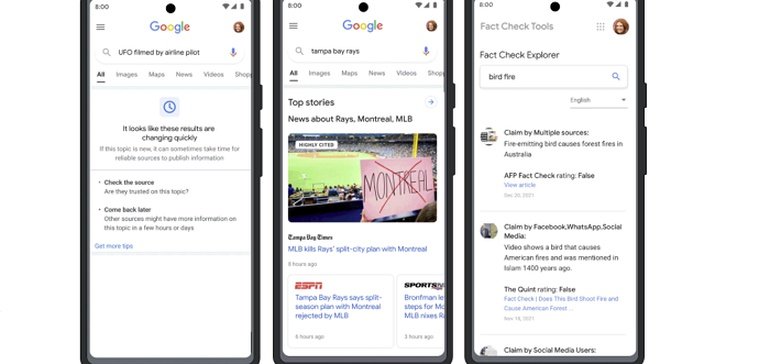SOCIAL
Google Adds New Tools to Help Limit the Spread of Misinformation Online

With International Fact-Checking Day coming up on April 2nd, Google has provided a new overview of its evolving efforts to detect misinformation online, and limit the reach of false reports in partnership with its fact-checking partners.
Google has significantly ramped up its efforts to address misinformation, with a range of Search upgrades and alerts to help users better understand the sources that they’re connecting with for updates.
And now, Google’s bringing more tools to the fight.
First off, Google’s adding a new notice on evolving news stories which will alert searchers that the facts are still being clarified.
As you can see in this example, the new alerts, rolling out for English-language searches in the US, will make the searcher aware of the evolving nature of the story, and will include tips to help the user evaluate information online, like a reminder of the importance of relying trusted sources.
Small prompts like this are often all that’s required to get users to take a moment of pause for clarity on such, before re-distributing false narratives, while it could also serve as a learning tool to improve digital literacy, by underlining the dangers of trusting everything that you read online.
Google’s also adding a new ‘Highly Cited’ label to help users find the source info for major news stories.

As explained by Google:
“Let’s say a local news organization breaks an investigative story looking into problems at your local school district. The story is so big that it gets picked up by numerous other media outlets. But what if you didn’t see that original story, which had unique context for local residents? We’re introducing a way to help you identify stories that have been frequently cited by other news organizations, giving you a simple way to find the most helpful or relevant information for a news story.”
The new label will appear on Top Stories, while everything from articles, to interviews to press releases will be eligible for the new tag.
And aside from promoting key source research, Google’s also hoping that it will help to elevate original reporting, “making it even easier for people to discover and engage with the publishers and journalists whose work brings unique value to a story.”
The highly cited label is launching soon on mobile in English for the US, with other regions to follow in the coming weeks.
In addition to these upgrades, Google also suggests that Searchers familiarize themselves with its Fact Check Explorer tool, which enables users to search for any topic that they have questions about, and cross-references over 150,000 fact checks to provide more context.

While you can also cross-check the history of any website via the Search results page.

Google also highlights its continued support of a number of fact-checking programs through its Google News Initiative, helping to enhance the expertise available to examine and verify online information.
Which is a battle that can never be won, not fully, as the rapid pace of online publishing makes it impossible to completely stop the spread of false and misleading information, either via bad actors or unwitting users and publications. But it can be slowed significantly. With the right systems in place, Google, as well as all the other major platforms, can detect and limit the spread of potentially harmful untruths, and stop them from gaining viral traction, which is the key focus of initiatives like this.
Still, Google-owned YouTube remains a key source of misinformation, while Google also inadvertently funds many click-bait farms through its ad tools. As such, it clearly has a way to go in addressing these elements, but every step is another move in the right direction, and it’s good to see Google continuing to evolve its fact-checking programs, especially as people increasingly rely on online sources over more traditional (legacy?) news outlets.
You can read more about Google’s evolving fact-checking and misinformation detection efforts here.
Source link
SOCIAL
Snapchat Explores New Messaging Retention Feature: A Game-Changer or Risky Move?

In a recent announcement, Snapchat revealed a groundbreaking update that challenges its traditional design ethos. The platform is experimenting with an option that allows users to defy the 24-hour auto-delete rule, a feature synonymous with Snapchat’s ephemeral messaging model.
The proposed change aims to introduce a “Never delete” option in messaging retention settings, aligning Snapchat more closely with conventional messaging apps. While this move may blur Snapchat’s distinctive selling point, Snap appears convinced of its necessity.
According to Snap, the decision stems from user feedback and a commitment to innovation based on user needs. The company aims to provide greater flexibility and control over conversations, catering to the preferences of its community.
Currently undergoing trials in select markets, the new feature empowers users to adjust retention settings on a conversation-by-conversation basis. Flexibility remains paramount, with participants able to modify settings within chats and receive in-chat notifications to ensure transparency.
Snapchat underscores that the default auto-delete feature will persist, reinforcing its design philosophy centered on ephemerality. However, with the app gaining traction as a primary messaging platform, the option offers users a means to preserve longer chat histories.
The update marks a pivotal moment for Snapchat, renowned for its disappearing message premise, especially popular among younger demographics. Retaining this focus has been pivotal to Snapchat’s identity, but the shift suggests a broader strategy aimed at diversifying its user base.
This strategy may appeal particularly to older demographics, potentially extending Snapchat’s relevance as users age. By emulating features of conventional messaging platforms, Snapchat seeks to enhance its appeal and broaden its reach.
Yet, the introduction of message retention poses questions about Snapchat’s uniqueness. While addressing user demands, the risk of diluting Snapchat’s distinctiveness looms large.
As Snapchat ventures into uncharted territory, the outcome of this experiment remains uncertain. Will message retention propel Snapchat to new heights, or will it compromise the platform’s uniqueness?
Only time will tell.
SOCIAL
Catering to specific audience boosts your business, says accountant turned coach

While it is tempting to try to appeal to a broad audience, the founder of alcohol-free coaching service Just the Tonic, Sandra Parker, believes the best thing you can do for your business is focus on your niche. Here’s how she did just that.
When running a business, reaching out to as many clients as possible can be tempting. But it also risks making your marketing “too generic,” warns Sandra Parker, the founder of Just The Tonic Coaching.
“From the very start of my business, I knew exactly who I could help and who I couldn’t,” Parker told My Biggest Lessons.
Parker struggled with alcohol dependence as a young professional. Today, her business targets high-achieving individuals who face challenges similar to those she had early in her career.
“I understand their frustrations, I understand their fears, and I understand their coping mechanisms and the stories they’re telling themselves,” Parker said. “Because of that, I’m able to market very effectively, to speak in a language that they understand, and am able to reach them.”Â
“I believe that it’s really important that you know exactly who your customer or your client is, and you target them, and you resist the temptation to make your marketing too generic to try and reach everyone,” she explained.
“If you speak specifically to your target clients, you will reach them, and I believe that’s the way that you’re going to be more successful.
Watch the video for more of Sandra Parker’s biggest lessons.
SOCIAL
Instagram Tests Live-Stream Games to Enhance Engagement

Instagram’s testing out some new options to help spice up your live-streams in the app, with some live broadcasters now able to select a game that they can play with viewers in-stream.
As you can see in these example screens, posted by Ahmed Ghanem, some creators now have the option to play either “This or That”, a question and answer prompt that you can share with your viewers, or “Trivia”, to generate more engagement within your IG live-streams.
That could be a simple way to spark more conversation and interaction, which could then lead into further engagement opportunities from your live audience.
Meta’s been exploring more ways to make live-streaming a bigger consideration for IG creators, with a view to live-streams potentially catching on with more users.
That includes the gradual expansion of its “Stars” live-stream donation program, giving more creators in more regions a means to accept donations from live-stream viewers, while back in December, Instagram also added some new options to make it easier to go live using third-party tools via desktop PCs.
Live streaming has been a major shift in China, where shopping live-streams, in particular, have led to massive opportunities for streaming platforms. They haven’t caught on in the same way in Western regions, but as TikTok and YouTube look to push live-stream adoption, there is still a chance that they will become a much bigger element in future.
Which is why IG is also trying to stay in touch, and add more ways for its creators to engage via streams. Live-stream games is another element within this, which could make this a better community-building, and potentially sales-driving option.
We’ve asked Instagram for more information on this test, and we’ll update this post if/when we hear back.
-

 PPC6 days ago
PPC6 days ago19 Best SEO Tools in 2024 (For Every Use Case)
-

 MARKETING7 days ago
MARKETING7 days agoEcommerce evolution: Blurring the lines between B2B and B2C
-
SEARCHENGINES5 days ago
Daily Search Forum Recap: April 19, 2024
-
SEARCHENGINES6 days ago
Daily Search Forum Recap: April 18, 2024
-

 WORDPRESS6 days ago
WORDPRESS6 days agoHow to Make $5000 of Passive Income Every Month in WordPress
-

 SEO7 days ago
SEO7 days ago2024 WordPress Vulnerability Report Shows Errors Sites Keep Making
-

 WORDPRESS7 days ago
WORDPRESS7 days ago10 Amazing WordPress Design Resouces – WordPress.com News
-

 SEO6 days ago
SEO6 days ago25 WordPress Alternatives Best For SEO












You must be logged in to post a comment Login